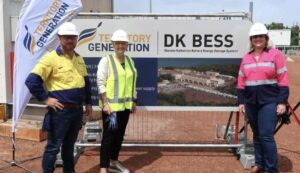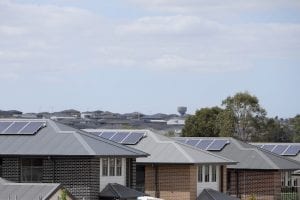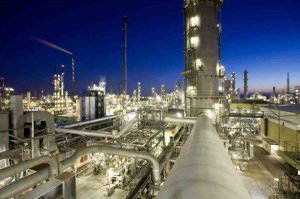The Albanese government is being hailed for delivering the biggest spend on clean energy in Australia’s history, in a federal budget that climate and renewable energy leaders say marks a significant turning point for an economy long shackled to the fortunes of coal and gas.
Federal Treasurer Jim Chalmers on Tuesday evening announced $21 billion of new funding initiatives under the Future Made in Australia Act strategic framework as part of the 2024-2025 Federal Budget, including nearly a $14 billion boost to the critical minerals and green hydrogen sectors, through production tax credits.
The Australian Renewable Energy Agency also got a $5.1 billion boost, including $1.5 billion to support solar and battery manufacturing and $1.7 billion for an innovation fund for industries such as green metals and low-carbon liquid fuels.
Elsewhere there was spending on battery storage development, green jobs, project development and approval reform, First Nations participation, and climate and energy diplomacy.
Equally notable, however, has been the absence of new funding for fossil fuels – not even for gas, which takes at least some of the sting out of the baffling “Future Gas Strategy” that was released by the same government last week.
Climate Council CEO Amanda McKenzie says this sends “an essential signal” across Australia’s entire economy.
“Gas and coal are not part of the budget’s vision for a Future Made in Australia, underlining that our next era of prosperity can be built on cleaner foundations,” McKenzie says.
“The budget makes an important and overdue opening bid to claim our place as one of the world’s clean energy market leaders.
“Both sides of politics should back this vision for Australia,” McKenzie says.
“This is a Budget that puts renewable energy at the centre of our economic future,” says Clean Energy Council CEO Kane Thornton.
“The Clean Energy Council has long advocated for a response to the United States Inflation Reduction Act and this Budget delivers on that.”
Climate Energy Finance executive director Tim Buckley, who wants to see $100 billion of capital and budget support for net-zero industries over the coming decade, says the 2024-25 budget is a promising downpayment on this.
“We clearly needed this budget to respond strategically, proportionally and fast, which it has done.
“It shows a government that understands both this imperative to act to transition Australia to its future as a clean, green superpower and the opportunity cost and risks of not moving to secure Australia’s place in the emerging net zero world,” Buckley says – adding that, after “the travesty” of the Future Gas Strategy, “it was a relief to see zero new funding for fossil gas.”
Buckley is particularly pleased with the development of a production tax credit (PTC) model for critical minerals and green hydrogen, which he describes as “a very strong step forward,” and “a clear acknowledgement that Australia can’t simply leave it to free markets when other countries have made such significant national-interest investment interventions.”
“This PTC will leverage Federal Energy Minister Bowen’s 82% Renewables by 2030 initiative, boosted by the 32GW Capacity Investment Scheme which is driving the rollout of utility scale firmed renewables by underpinning private investment, so Australia can power our critical minerals refineries and manufacturing with clean energy,” Buckley says.
“This means we can ’embody decarbonisation’ in our exports.”
Rod Sims, the former competition tsar regularly invoked by the federal opposition when it is rubbishing Labor’s Future Made in Australia plan for solar, says the approach taken in Treasury’s National Interest Framework is “excellent.”
“Australia’s advantages relative to the rest of the world are such that we can materially improve the prospects of achieving the world’s climate objectives,” says Sims, who is chair of The Superpower Institute.
“If Australia can make green aviation and shipping fuel, green polysilicon, processed green metals, and green fertiliser (urea) then we will be self-sufficient in areas vital to our economy.
“But we will be doing this in areas where we have a comparative advantage as these products variously need renewable energy, hydrogen and biomass, which Australia has and can make at the lowest cost.”
Climateworks Centre sustainable economies lead, Kylie Turner, says the Future Made in Australia framework is a key climate pillar that could function as a national “net zero filter,” coordinating industry decisions and funnelling investment in the right direction.
“It’s precisely the kind of coordination the nation needs to make the most of its once-in-a-lifetime green economy transformation,” Turner says.
“This is a crucial year for Australia’s climate ambition, with the federal government’s sector decarbonisation plans expected to be released in the second half of 2024.
“If we get this right, generations of Australians can work in and benefit from a net zero nation run on renewable energy, with thriving clean industries and exports.”
On the other hand…
Of course, not all of the feedback has been positive – and even the praise must be measured from a baseline established by a decade of budgets that effectively ignored renewable energy and climate altogether.
A key criticism has been the absence of any new funding for household electrification, which is broadly considered to be a no-brainer to cut emissions, reduce gas consumption and cut the cost of living in a much more meaningful and lasting way than through a one-off $300 bill discount.
“This Federal Budget recognised energy bills are an important form of cost-of-living relief, yet missed the opportunity to provide households and small businesses with longer-term relief through greater support for rooftop solar and household batteries,” says Solar Citizens CEO Heidi Douglas.
“While we acknowledge many Australians will be seeking immediate power bill relief, government support for solar panels and home batteries would continue to deliver savings for up to 20 years.”
Solar Citizens says a “new burst” of federal government investment in rooftop solar is also missing from the budget.
“Rooftop solar provides the most economical possible energy to customers and everyone in Australia should have access to the cost-saving benefits of solar, regardless of their postcode, or whether they rent or live in an apartment or social housing,” Lee says.
Rewiring Australia, too, says more work needs to be done to bring households to the centre of energy and climate policy.
“That is the fastest, most cost effective way to reduce energy bills and help households move off dirt, fossil fuel gas onto cleaner, cheaper solar-generated electricity,” says Rewiring Australia executive director Dan Cass.
“The next step on Australia’s journey to Net Zero is for the Australian government to create a low-cost loan scheme for the millions of Australians who cannot afford the up-front investment to ditch expensive gas and petrol for cheap and healthy solar, EVs and electric appliances.
“This will be central to any credible climate policy at the next election and has unparalleled support across the political spectrum and broader community.”
The Australian Conservation Foundation notes that while there is no new direct funding to coal and gas in this year’s budget, there are other ways in which Australia’s fossil fuel industries are being propped up.
“On the other side of the budget coin, serious public money is still flowing to coal and gas, especially via the Fuel Tax Credit scheme and through funding for carbon capture and storage – technology designed to extend the use-by date of climate-damaging fossil fuels,” ACF CEO Kelly O’Shanassy says.
“It makes sense to fund the industries that help us solve climate change, not the industries that got us into this mess.”
“There is a long way to go before funding for the environment is at a scale needed to protect and restore nature and secure the services nature provides and on which we all depend,” O’Shanassy adds.
Missing pieces
Sims from The Superpower Institute says there are still two main net zero market failures that, unless addressed, will lead to picking losers.
“These market failures are the lack of a carbon price which means that green products do not compete on a level playing field with gas or coal products, because the latter do not pay for the damage they do to the environment,” he says.
“The other market failure is the need for support for first movers who bring known technology to scale despite inevitably making mistakes through ‘learning by doing’ which will cost them, but from which followers coming later will benefit.”
Climate Council’s head of policy, Jennifer Rayner says the next steps include stronger policies “to get all parts of our economy pulling in the same pollution-free direction,” and clear bipartisan support.
“The investments in this budget will need to ramp up in the next term of government and beyond. All political parties must now make clear that Australia is open for clean business with good new jobs, no matter who is in charge,” Rayner says.
On social licence, advocacy groups are calling for governments to extend their clean energy budget ambition to the cause of building trust with regional communities who are critical partners in the transition.
RE-Alliance and Community Power Agency note that their call for federally funded network of 50 independent Local Energy Hubs in regions with large amounts of current or proposed renewable energy developments and transmission lines was not answered in the budget.
“$10 million over two years, that will include delivery of public information on the net zero transition, is something we’ve been calling for and will help inform regional communities,” says RE Alliance national director Andy Bray.
“We have a once-in-a-generation opportunity to ensure that the shift to renewables delivers logical, local, long-term benefits for farmers, local councils and regional communities,” Bray says.
“We can see a $20.7 million commitment to improving community engagement and community benefits which is really promising. …This is a start but we’re hopeful the government will up their ambition in building trust in the regions by the time we get to the mid-year budget update.”
Carbon Market Institute CEO John Connor says the budget’s downpayments to boost the renovation of Australia’s carbon market and its role on the global climate stage are positive, but just a start.
“We welcome the $48 million boost to ongoing ACCU scheme reforms, including for the federal department (DCCEEW), and to establish the Carbon Abatement Integrity Committee to roll out the new proponent-led method development process, and improve transparency,” Connor says.
“This includes important investments to help Indigenous land managers to participate in the scheme. There’s also $40.9 million for the establishment of the Nature Repair Market, and its methods and administration, as well as a welcome $63.8 million over ten years to support emissions reductions in the agriculture and land sectors.
“Nevertheless, the budget leaves key investment details still to be clarified. In particular, around the role of the Commonwealth as an investor in the ACCU scheme, and how it plans to scale up and stimulate investment in the ACCU and Nature Repair Market over the next few years, beyond least-cost investments under the Safeguard Mechanism.”
“An extra $76.2 million for international climate change engagement includes extra funding for UNFCCC, International Energy Agency and the COP31 Presidency bid. … If successful, a COP will require further financial backing, but this should be seen as an investment in broader climate responsibility and engagement beyond the event itself.”
Connor also says that the broader budget investments in hydrogen, critical minerals, low emissions agriculture and regulatory frameworks need to be supercharged by the Net Zero Plan currently in development, as well as stronger emission reduction targets for 2035 and 2050.










